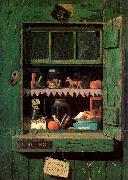 |
Peto, John Frederick -- Click Here
|
|
American, 1854-1907
American painter. He trained at the Pennsylvania Academy of Fine Arts (1877-8), Philadelphia, where he became a friend of William Michael Harnett whose work was a dominant influence on his oeuvre. Peto maintained a studio in Philadelphia, exhibiting at the Academy from 1879 to 1887; he earned a living through occasional work as a photographer, sculptor and painter. After moving to Island Heights, NJ, in 1889, |
|
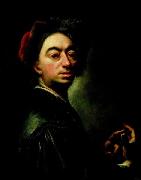 |
Peter Johannes Brandl -- Click Here
|
|
Petr Brandl (Peter Johannes Brandl or Jan Petr Brandl) (October 24, 1668 - September 24, 1735) was a painter of the late Baroque, famous in his time but - due to isolation behind the Iron Curtain - rather forgotten until recently. He was of German-speaking Austrian descent in the bilingual kingdom of Bohemia. His mother was from Czech peasant family, that lived in Přestanice (a village in Bohemia, now part of Hlavnovice). According to the Grove Dictionary of Art and other sources, Brandl was born into a craftsmanes family (his father seems to have been a goldsmith) and apprenticed around 1683 - 1688 to Kristien Schröder (1655 - 1702).
Brandl employed strong chiaroscuro, areas of heavy impasto and very plastic as well as dramatic figures. The major art museum in Prague, called the National Gallery, has an entire hall devoted to the artist's works, including the wonderful "Bust of an Apostle" from some time before 1725. |
|
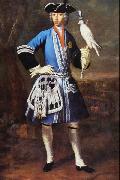 |
Peter Jakob Horemans -- Click Here
|
|
painted Portrait of Clemens August as Falconer in 18th century
|
|
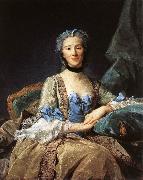 |
PERRONNEAU, Jean-Baptiste -- Click Here
|
|
French Rococo Era Painter, ca.1715-1783
French pastellist, painter and engraver. He was, with his older contemporary Maurice Quentin de La Tour, the most important pastel artist and portrait painter in 18th-century France. Perronneau trained first with the engraver Laurent Cars and then with the successful portrait painter Hubert Drouais. His work as an engraver, which includes prints after Charles-Joseph Natoire, Fran?ois Boucher, Edme Bouchardon and Carle Vanloo (see Vaillat and Ratouis de Limay,), did not continue beyond the 1730s. Nevertheless, his involvement with Cars, much of whose work consisted in the reproduction of portraits by artists such as Hyacinthe Rigaud, left its mark on the composition of his pastels, most of which employ the bust-length format, often within a feigned stone oval typical of 17th- and 18th-century engraved portraits. His early pastel portrait of Mme Desfriches (1744; France, A.M. Ratouis de Limay priv. col.), mother of his friend and patron, the Orl?ans collector Aignan-Thomas Desfriches, |
|
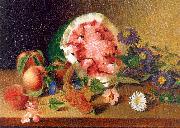 |
Peale, James -- Click Here
|
|
American, 1749-1831
Painter, brother of Charles Willson Peale. Charles encouraged him to become a painter; James also worked as a frame-maker for his brother until the Revolution, in which he served as a lieutenant. From 1779 James shared Charles's practice, specializing in miniatures. His early work, occasionally confused with Charles's, shows his brother's influence. After 1794, his style became clearly his own: more delicate with subtle colour harmonies, softened outlines and free handling; it may be distinguished by a faint violet tone in the shadows and the inconspicuous signature 'IP'. His miniatures of male subjects are frequently superior to his portraits of women, for example Benjamin Harwood (1799; Baltimore, Mus. & Lib. MD Hist.), but his meticulous attention to costume and his success in imparting colour and sparkle to skin and eyes, |
|
|
|
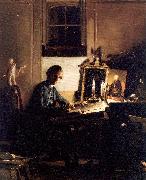 |
Paye, Richard Morton -- Click Here
|
|
English, 1750-1821 |
|
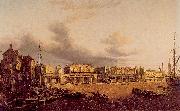 |
Paul, John -- Click Here
|
|
English, active 1858-1886 |
|
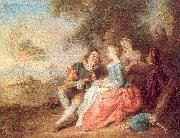 |
Pater, Jean-Baptiste -- Click Here
|
|
French Rococo Era Painter, 1695-1736
French painter and draughtsman. He was taught in Valenciennes by Jean-Baptiste Guid? (master 1697; d 1711) and also by his father, Antoine Pater (1670-1747), a sculptor whose portrait was painted by Antoine Watteau (Valenciennes, Mus. B.-A.), who was also a native of Valenciennes. He probably followed Watteau to Paris after the short stay that the latter made in Valenciennes around 1710. Pater thus became a pupil of Watteau. Watteau's difficult character led to Pater's dismissal. He then spent a few hard years on his own in Paris, before returning to Valenciennes around 1715 or 1716. He tried to work independently of the local corporation of St Luc, of which he was not a member; a number of comical legal difficulties ensued, and Pater returned to Paris in 1718. There he must have been in contact with Watteau, since he worked for some of the latter's clients, such as the dealers Pierre Sirois and Edm?-Fran?ois Gersaint, and the collector Jean de Jullienne. In the spring of 1721 the dying Watteau called Pater to him at Nogent, near Paris, apparently full of remorse for his previous attitude and wishing to instruct him in the basic tenets of his painting, |
|
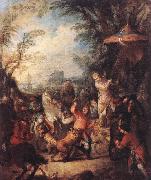 |
PATER, Jean Baptiste Joseph -- Click Here
|
|
French Rococo Era Painter, 1695-1736 |
|
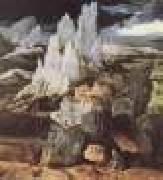 |
PATENIER, Joachim -- Click Here
|
|
Flemish painter (b. ca. 1480, Bouvignes, d. 1524, Antwerpen).
|
|
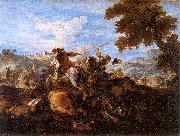 |
Parrocel, Joseph -- Click Here
|
|
French, 1646-1704
He studied with his father Barthelemy Parrocel (1595-1660) and then with his elder brother Louis Parrocel (1634-94). He went to Paris for four years to perfect his work and then, c. 1667, to Rome, where he became the pupil of the battle painter Jacques Courtois and was influenced by Salvator Rosa. He remained in Italy for eight years and stayed for a time in Venice, before returning to settle in Paris in 1675. He was approved (agree) by the Academie Royale de Peinture et de Sculpture in February 1676 and received as a full member in November of the same year, presenting the Siege of Maastricht (Draguignan, Mus. Mun.). His painted oeuvre consists principally of military scenes, particularly battles, and he received numerous royal commissions. In the period 1685-8 he executed 11 paintings for the Salle du Grand Couvert at the cheteau of Versailles (nine in situ; one in Tours, Mus. B.-A.; one in Dijon, Mus. B.-A.); in 1699 he painted the Crossing of the Rhine (Paris, Louvre.) for the cheteau of Marly, Yvelines, and in 1700 he executed the Fair at Bezons (Tours, Mus. B.-A.), anticipating the fetes galantes of Antoine Watteau. He was also the author of a number of hunting scenes . His most important religious paintings were the May of Notre-Dame de Paris of 1694, St John the Baptist Preaching (Arras, Mus. B.-A.) and St Augustin Succouring the Sick (c. 1703; Nantes, Mus. B.-A.), which was intended for the monastery in the Place des Victoires in Paris. He also contributed battle scenes to the backgrounds of portraits by Hyacinthe Rigaud and by Gabriel Blanchard. His technique was highly original in the context of his time; he employed a very free style of execution and used thick impasto and intense colours. He was also a prolific engraver, producing around 100 plates, |
|
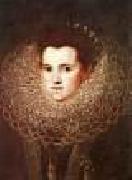 |
PANTOJA DE LA CRUZ, Juan -- Click Here
|
|
Spanish Painter, 1553-1608
Spanish painter. He must have moved to Madrid when he was very young, receiving his training in the workshop of Alonso S?nchez Coello, painter to Philip II. On numerous occasions he declared himself to be a follower of S?nchez Coello, in whose workshop he was an oficial, and he probably collaborated to a considerable degree on many of his master's mature works. There are very few signed works by Pantoja from before the death of S?nchez Coello, although some anonymous paintings from the workshop are probably by him. In Madrid in 1587 Pantoja married a woman of some means, and by the following year, when S?nchez Coello died, he was an independent painter, aspiring to his master's position. Documentation exists from 1590 concerning portraits by Pantoja of members of the royal family including one of Don Felipe, the future Philip III (1593; Vienna, Ksthist. Mus.). On Philip's accession to the throne in 1598 Pantoja painted another portrait of him (Vienna, Ksthist. Mus.) and became the official portrait painter for the court and for the nobility of Madrid; there is detailed documentation for his work from this time. He painted clothing and jewels with precision, in minute detail and with a dry objectivity in the Flemish tradition. His treatment of faces, however, clearly reveals his study of Venetian portraiture, and in particular that of Titian, as well as sharp psychological penetration. In his portraits of royal children he maintained, albeit with a certain rigidity, the charm that S?nchez Coello in his paintings had given these infant figures tightly swathed in official robes |
|
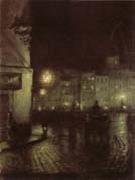 |
Pankiewicz, Jozef -- Click Here
|
|
1866-1940
Jozef Pankiewicz (Lublin November 29 1866 - July 4 1940) was a Polish painter, graphic artist, and pedagogue. In his summer years he studied under Wojciech Gerson and Alexander Kaminski. He travelled to Saint Petersburg with Władysław Podkowinski after winning a scholarship to the Imperial Academy of Arts there. In 1889, both artists left for Paris. |
|
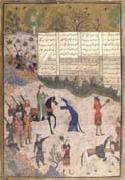 |
Painter Junayd -- Click Here
|
|
the period the 1465-1535
|
|
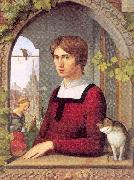 |
Overbeck, Johann Friedrich -- Click Here
|
|
German Painter, 1789-1869
German religious painter. Expelled from the Vienna Academy because of his opposition to its classicism, he went to Rome and with Peter von Cornelius, Veit, Schadow-Godenhaus, and others, formed the group known as the Nazarenes. His first real successes were his frescoes for the Casa Bartholdy (now in Berlin) and for the Villa Massimo. Among his notable paintings are Christ's Entry into Jerusalem and Christ's Agony in the Garden. Overbeck sought to make his art serve religion. |
|
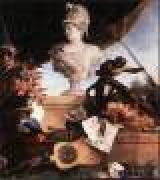 |
OUDRY, Jean-Baptiste -- Click Here
|
|
French Baroque Era Painter, 1686-1755
French painter. He was the principal animal painter and one of the foremost decorative painters during the first half of Louis XV's reign. After initial training as a portrait painter, he concentrated on still-lifes; by the 1720s he had also begun to establish himself as a specialist in hunting scenes, game-pieces and portraits of animals. He ran an active workshop, often keeping his best originals for years and selling copies and (more or less autograph) variants. In the 1730s he was most active as a tapestry designer, making numerous designs for the royal tapestry works of Beauvais and the Gobelins, and he continued to produce his brilliantly painted hunts, still-lifes and studies of animals and birds to the end of his career. |
|
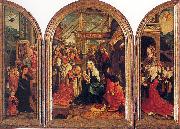 |
Oostsanen, Jacob Cornelisz van -- Click Here
|
|
Flemish, 1472-1533 |
|
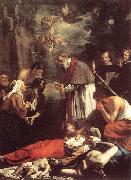 |
OOST, Jacob van, the Younger -- Click Here
|
|
Flemish painter (b. 1639, Brugge, d. 1713, Brugge) |
|
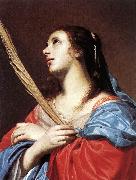 |
OOST, Jacob van, the Elder -- Click Here
|
|
Flemish Baroque Era Painter, ca.1601-1671 |
|
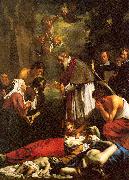 |
Oost, Jacob van the Younger -- Click Here
|
|
Flemish, 1637-1713 |
|
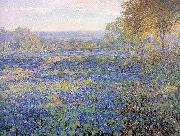 |
Onderdonk, Julian -- Click Here
|
|
American, 1882-1922
was a Texan Impressionist painter, often called "the father of Texas painting." He attended West Texas Military Academy and was graduated in 1900. Julian Onderdonk was born in San Antonio, TX to Robert Jenkins Onderdonk (a painter) and Emily Gould Onderdonk. He was raised in South Texas and was an enthusiastic sketcher and painter. At 19, with the help of a generous neighbor, Julian left Texas in order to study with the renowned American Impressionist William Merritt Chase. Julian's father, Robert, has also once studied with Chase. Julian spent the summer of 1901 on Long Island at Chase's Shinnecock School of Art. He studied with Chases for a couple of years and then moved to New York to attempt to make a living as an eu plain aire artist. While in New York he met and married Gertrude Shipman and they soon had a son. |
|
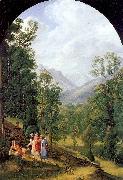 |
Olivier, Johann Heinrich Ferdinand -- Click Here
|
|
German, 1785-1841 |
|
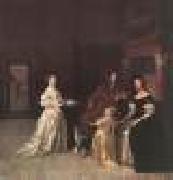 |
OCHTERVELT, Jacob -- Click Here
|
|
Dutch Baroque Era Painter, 1634-1682
Dutch painter. According to Houbraken, he and Pieter de Hooch were fellow students of the Dutch Italianate Nicolaes Berchem in Haarlem, probably between 1646, when Berchem returned from Italy, and 1655, when Ochtervelt married Dirkje Meesters in the Dutch Reformed Church in Rotterdam. Ochtervelt's earliest known works reveal the influences of a number of Dutch Italianate painters. Landscapes with figures, such as Hunters and Shepherds in a Landscape (1652; Karl-Marx-Stadt, St?dt. Kstsamml.), owe much to Berchem in subject and composition. They may also have been partly inspired by similar landscapes by Jan Baptist Weenix and Ludolf de Jongh. Towards the mid-1650s Ochtervelt began painting garden scenes |
|
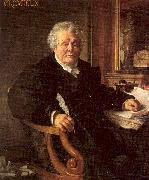 |
Nouy, Jean Lecomte du -- Click Here
|
|
French, 1842-1923
was an orientalist French painter and sculptor. He was Charles Gleyre's and Jean-Leon Gerôme's pupil. A Paris street was named after him in 1932. |
|
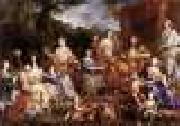 |
NOCRET, Jean -- Click Here
|
|
French painter (b. 1617, Nancy, d. 1672, Paris). |
|
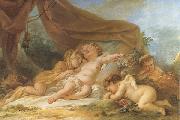 |
Nicolas-rene jollain -- Click Here
|
|
French Painter, 1732-1804 |
|
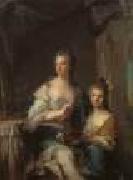 |
NATTIER, Jean-Marc -- Click Here
|
|
French Rococo Era Painter, 1685-1766
Brother of Jean-Baptiste Nattier. As well as being taught by his father, he trained with his godfather, Jean Jouvenet, and attended the drawing classes of the Acad?mie Royale, where in 1700 he won the Premier Prix de Dessin. From around 1703 he worked on La Galerie du Palais du Luxembourg. The experience of copying the work of Rubens does not, however, seem to have had a liberating effect on his draughtsmanship, which was described by the 18th-century collector Pierre-Jean Mariette as 'cold'. Nattier was commissioned to make further drawings for engravers in the early part of his career, including those after Hyacinthe Rigaud's famous state portrait of Louis XIV (1701; Paris, Louvre) in 1710, which indicates that he had established a reputation while he was still quite young. Although he was offered a place at the Acad?mie de France in Rome on the recommendation of Jouvenet, Nattier preferred to remain in Paris and further his career. In 1717 he nevertheless made a trip to Holland, where he painted portraits of Peter the Great and the Empress Catherine (St Petersburg, Hermitage). |
|
|
|
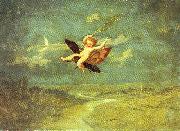 |
Naish, John George -- Click Here
|
|
English, 1824-1905 |
|
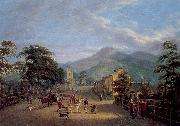 |
Mulvany, John George -- Click Here
|
|
Irish, 1766-1838 |
|
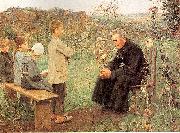 |
Muenier, Jules-Alexis -- Click Here
|
|
French Academic Painter, 1863-1942 |
|
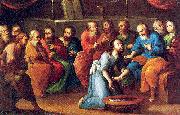 |
Mota, Jose de la -- Click Here
|
|
Mexican, Active 1708-25 |
|
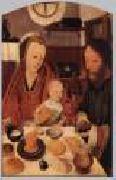 |
MOSTAERT, Jan -- Click Here
|
|
Dutch Northern Renaissance Painter, ca.1472-1555 |
|
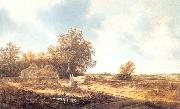 |
Moscher, Jacob van -- Click Here
|
|
Dutch Baroque Era Painter, 1615-1655 |
|
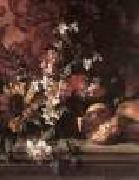 |
MONNOYER, Jean-Baptiste -- Click Here
|
|
French Baroque Era Painter, ca.1634-1699 |
|
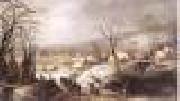 |
MOMPER, Joos de -- Click Here
|
|
Flemish painter (b. 1564, Antwerpen, d. 1634/35, Antwerpen).
also known as Josse de Momper, is one of the most important Flemish landscape painters between Pieter Brueghel the Elder and Peter Paul Rubens. Brueghel's influence is clearly evident in this many of de Momper's paintings. Born in 1564 in Antwerp, Joos de Momper was first apprenticed to his father. In the 1580s, he travelled to Italy to study art. De Momper primarily painted landscapes, the genre for which he was well-regarded during his lifetime. He painted both fantasy landscapes, viewed from a high vantage point and employing a conventional Mannerist color transition of brown in the foreground to green and finally blue in the background, and more realistic landscapes with a lower viewpoint and more natural colors. His wide panoramas also feature groups of figures. |
|
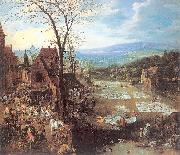 |
Momper II, Joos de -- Click Here
|
|
Flemish Baroque Era Painter, 1564-1635 |
|
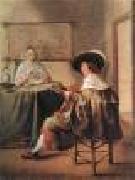 |
MOLENAER, Jan Miense -- Click Here
|
|
Dutch painter (b. ca. 1610, Haarlem, d. 1668, Haarlem).
Dutch painter and draughtsman. The surprisingly large oeuvre of this remarkably versatile genre painter displays an inventive symbolism, wit and humour, which identify him as the true forerunner of Jan Steen. |
|
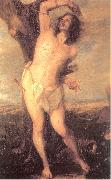 |
Miranda, Juan Carreno de -- Click Here
|
|
Spanish, 1614-1685
was a Spanish painter of the Baroque period. Born in Avil's in Asturias, son of a painter with the same name, Juan Carreño de Miranda. His family moved to Madrid in 1623, and he trained in Madrid during the late 1620s as an apprentice to Pedro de Las Cuevas and Bartolom Roman. He came to the notice of Velezquez for his work in the cloister of Doña Maria de Aragen and in the church of El Rosario. In 1658 Carreño was hired as an assistant on a royal commission to paint frescoes in the Alcezar palace, now the Royal Palace of Madrid. In 1671, upon the death of Sebastian de Herrera, he was appointed court painter to the queen (pintor de cemara) and began to paint primarily portraits. He refused to be knighted in the order of Santiago, saying Painting needs no honors, it can give them to the whole world. He is mainly recalled as a painter of portraits. His main pupils were Mateo Cerezo, Cabezalero, Donoso, Ledesma y Sotomayor. He died in Madrid. Noble by descent, he had an understanding of the workings and psychology of the royal court as no painter before him making, his portraits of the Spanish royal family in an unprecedented documentary fashion |
|
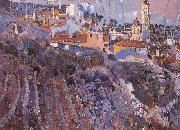 |
Mir, Joaquin -- Click Here
|
|
Spanish Painter, 1873-1940 |
|
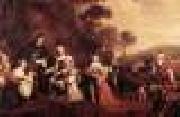 |
MIJTENS, Jan -- Click Here
|
|
Dutch Baroque Era Painter, ca.1614-1670
Nephew of Daniel Mijtens I. He was the son of Daniel's elder brother David, a saddle-maker in The Hague. Jan may have learnt to paint from his uncle Isaac Mijtens. After 1634 he may have trained with his uncle Daniel, who had by then returned to The Hague; Jan married Daniel's daughter Anna in 1642. In 1639 he had been admitted to The Hague's guild of painters, of which he became a governor in 1656. In the latter year he helped to found the painters' society De Pictura; from 1667-8 he was a governor of this society and from 1669-70 its dean. |
|
 |
Miel, Jan -- Click Here
|
|
Dutch Baroque Era Painter, ca.1599-1664
Flemish painter, active in Italy. Miel must have arrived in Rome in the early 1630s; he immediately came under the influence of Pieter van Laer (il Bamboccio) and the BAMBOCCIANTI. His earliest paintings of bambocciate (low-life scenes) are the Bowls Players (1633; Paris, Louvre) and its companion piece The Cobbler (Besan?on, Mus. B.-A. & Arch?ol.). Shortly after his arrival in Rome, Miel joined the Schildersbent, a confraternity of Netherlandish artists, and was given the nickname 'Bieco' ('threatening look'). His presence in Rome is documented from 1636 to 1658, when he moved to Turin and entered the service of Charles-Emanuel II, Duke of Savoy. Other early paintings that can be attributed to the 1630s include Halt at the Inn (Marseille, Mus. B.-A.) and Hunters' Rest (Warsaw, N. Mus.). Both are reworkings, in their subject-matter and composition, of contemporary paintings by van Laer |
|
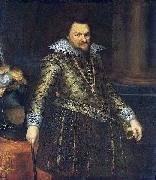 |
Michiel Jansz. van Mierevelt -- Click Here
|
|
(Delft, 1567 - Delft 27 June 1641) was a Dutch Golden Age painter.
He was the son of a goldsmith, who apprenticed him to the copperplate engraver Hieronymus Wierix. He subsequently became a pupil of Willem Willemz and Augusteyn of Delft, until Anthonie van Montfoort (Houbraken calls him Antony Blokland), who had seen and admired two of Mierevelt's early engravings, Christ and the Samaritan and Judith and Holofernes, invited him to enter his school at Utrecht.
He registered as a member of the Guild of St. Luke in The Hague in 1625.Devoting himself first to still lifes, he eventually took up portraiture, in which he achieved such success that the many commissions entrusted to him necessitated the employment of numerous assistants, by whom hundreds of portraits were turned out in factory fashion. Today over 500 paintings are or have been attributed to him.The works that can with certainty be ascribed to his own brush are remarkable for their sincerity, severe drawing and harmonious color, but comparatively few of the two thousand or more portraits that bear his name are wholly his own handiwork. So great was his reputation that he was patronized by royalty in many countries and acquired great wealth. The king of Sweden and the count palatine of Neuburg presented him with golden chains; Albert VII, Archduke of Austria, at whose court he lived in Delft, gave him a pension; and Charles I vainly endeavoured to induce him to visit the English court.
Though Mierevelt is chiefly known as a portrait painter, he also executed some mythological pieces of minor importance. Many of his portraits have been reproduced in line by the leading Dutch engravers of his time. He died at Delft.
The Rijksmuseum in Amsterdam has the richest collection of Mierevelt's works, chief of them being the portraits of William, Philip William, Maurice, and Frederick Henry of Orange, and of the count palatine Frederick V. At the Mauritshuis in The Hague are the portraits of four princes of the house of Orange, of Frederick V as king of Bohemia, and of Louise de Coligny as a widow. Other portraits by him are at nearly all the leading continental galleries, notably at Brunswick (3), Gotha (2), Schwerin (3), Munich (2), Paris (Louvre, 3), Dresden (4), Berlin (2), and Darmstadt (3). The town hall of Delft also has numerous examples of his work.
|
|
|
|
Meyer, Jeremiah -- Click Here
|
|
English Painter, 1735-1789
German enameller and painter, active in England. He was the son of a portrait painter at the court of W?rttemberg. He arrived in England c. 1749 and studied in London at St Martin's Lane Academy and then (1757-8) under Christian Friedrich Zincke; as a result of this training, much of Meyer's early work was painted on enamel. He exhibited (1760-67) at the Society of Artists and in 1761 was awarded its gold medal for a profile portrait of George III. In 1762 he became a naturalized Englishman. That year he was appointed miniature painter to Queen Charlotte and in 1764 painter in enamel to the King. Meyer was a founder-member of the Royal Academy and exhibited miniatures, enamels and watercolours there (1769-83). |
|
 |
Meliore di Jacopo -- Click Here
|
|
Italian, active ca.1260-1271
|
|
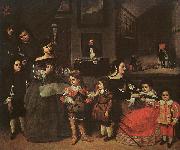 |
MAZO, Juan Bautista Martinez del -- Click Here
|
|
Spanish Baroque Era Painter, ca.1612-1667 |
|
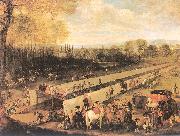 |
Mazo, Juan Bautista -- Click Here
|
|
Spanish Baroque Era Painter, ca.1612-1667 |
|
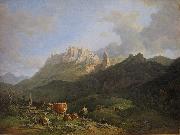 |
Max Joseph Wagenbauer -- Click Here
|
|
Maximilian Joseph Wagenbauer (1775 Grafing - 1829 Munich), was a Bavarian artist.
After finishing school, Wagenbauer attended drawing classes in Munich, under Johann Jakob Dorner the Elder (1741-1813). At the turn of the 19th century he was producing mostly Neo-Classical watercolour landscapes. He served in the military from 1797 to 1801, receiving a royal artist's annuity after his service through the influence of Johann Christian von Mannlich (1741-1822), architect and general building director of the dukes of Zweibre-ken. A condition of the royal stipend was that he produce paintings. He was appointed artist to the court and cabinet in 1802 and Inspector of the Royal Paintings Gallery in 1815. Wagenbauer focused increasingly on oil painting after 1810 and enjoyed the patronage of Maximilian I Joseph of Bavaria, who in 1811 commissioned him, Cantius Dillis (1779-1856) and Johann Jakob Dorner the Younger (1775-1852) to decorate the banquet hall at Schloss Nymphenburg with large paintings of Bavarian lakes. |
|
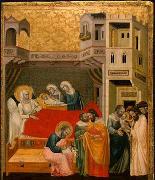 |
Master of the Life of Saint John the Baptist -- Click Here
|
|
Italian Byzantine Style Painter, 14th Century |
|
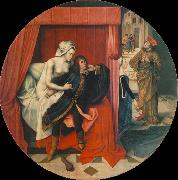 |
Master of the Joseph Legend -- Click Here
|
|
Flemish Northern Renaissance Painter, active ca.1500 |
|
|
|
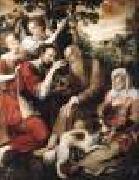 |
MASSYS, Jan -- Click Here
|
|
Netherlandish Painter, ca.1509-1575
Painter, son of Quinten Metsys. More so than his brother Cornelis Massys, who was a less talented artist, Jan worked in the style of his father, whose studio he may have taken over following his death in 1530. Two years later, though still under the age of majority, Jan was admitted as a master in the Guild of St Luke in Antwerp. Like Cornelis, he seems to have left Antwerp immediately after attaining the status of master, for he is not mentioned again in the archives. It has been suggested on stylistic grounds that he worked for a period at Fontainebleau, but this is disputed. He was, in any case, back in Antwerp by 1536, when he took on an apprentice, Frans van Tuylt. In 1538 he married Anna van Tuylt, by whom he had three children. |
|
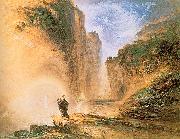 |
Martin, John -- Click Here
|
|
English Romantic Painter, 1789-1854 |
|
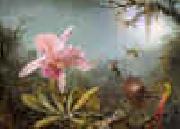 |
Martin Johnson Heade -- Click Here
|
|
American Hudson River School Painter, 1819-1904 Martin Johnson Heade (August 11, 1819-September 4, 1904) was a prolific American painter known for his salt marsh landscapes, seascapes, portraits of tropical birds, and still lifes. His painting style and subject matter, while derived from the romanticism of the time, is regarded by art historians as a significant departure from that of his peers.
Art historians have come to disagree with the common view that Heade is a Hudson River School painter, a view given wide currency by Heade's inclusion in a landmark exhibition of Hudson River School landscapes at the Metropolitan Museum of Art in 1987.
The leading Heade scholar and author of Heade's catalogue raisonn??, Theodore E. Stebbins, Jr., wrote some years after the 1987 Hudson River School exhibition that "...other scholars??myself included??have increasingly come to doubt that Heade is most usefully seen as standing within that school."
According to the Heade catalogue raisonn??, only around 40 percent of his paintings were landscapes. The remaining majority were still lifes, paintings of birds, and portraits, subjects unrelated to the Hudson River School. Of Heade's landscapes, perhaps only 25 percent were painted of traditional Hudson River School subject matter.
Heade had less interest in topographically accurate views than the Hudson River painters, and instead focused on mood and the effects of light. Stebbins writes, "If the paintings of the shore as well as the more conventional compositions...might lead one to think of Heade as a Hudson River School painter, the [marsh scenes] make it clear that he was not." |
|
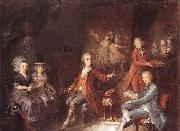 |
Martin Johann Schmidt -- Click Here
|
|
Austrian Painter, 1718-1801,was one of the most outstanding Austrian painters of the late Baroque/Rococo along with Franz Anton Maulbertsch. A son of the sculptor Johannes Schmidt and a pupil of Gottlieb Starmayr, he spent most of his life at Stein, where he mostly worked in the numerous churches and monasteries of his Lower Austrian homeland. While the evolution of his style after 1750 shows that he had either spent a formative period in northern Italy or had at least had extensive contact with northern Italian works of art prior to that date, his works are also clearly influenced by Rembrandt (visible above all in his etchings) and the great fresco-painters of the Austrian Baroque, Paul Troger and Daniel Gran. Despite not having received formal academic training, in 1768 he was made a member of the imperial academy at Vienna due to his artistic merits, which by that time had already been recognized by a wider public inside and outside of Austria. Primarily he painted devotional images for private devotion and churches, including a considerable number of large altar paintings. His lively and colourful style made him extremely popular with people from all levels of society already during his lifetime. From 1780 mythological and low-life themes became increasingly frequent, only to be replaced by a renewed concentration on religious topics during the very last years of Schmidt's life. He was at that an important draughtsman and has left numerous etchings which clearly show Rembrandt's influence. While his earlier works typically show a warm chiaroscuro, from about 1770 he used increasingly stronger and more lively colours. Simultanueously, both his style and his brush technique became much more free, making him, like Franz Anton Maulbertsch, an important predecessor of impressionism. In this aspect, his mature style is completely contrary to neoclassicism, the style which increasingly dominated European art after about 1780. |
|
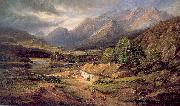 |
Marquis, James Richard -- Click Here
|
|
Irish, Scottish heritage, Active 1835-85 |
|
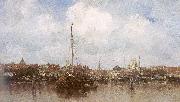 |
Maris, Jacob -- Click Here
|
|
Dutch, 1837-1899
was a Dutch painter, who with his brothers Willem and Matthijs belonged to what has come to be known as the Hague School of painters. Maris studied at the Antwerp Academy, and subsequently in Hubertus van Hove's studio during a stay in Paris from 1865 till 1871. He returned to Holland when the Franco-Prussian War broke out, and died there in August 1899. Though he painted, especially in early life, domestic scenes and interiors invested with deeply sympathetic feeling, it is as a landscape painter that Maris excelled. He was the painter of bridges and windmills, of old quays, massive towers, and level banks; even more was he the painter of water, and misty skies, and chasing clouds. In all his works, whether in water or oil color, and in his etchings, the subject is always subordinate to the effect. His art is suggestive rather than decorative, and his force does not seem to depend on any preconceived method, such as a synthetical treatment of form or gradations of tone. And yet, though his means appear so simple, the artist's mind seems to communicate with the spectator's by directness of pictorial instinct, and we have only to observe the admirable balance of composition and truthful perspective to understand the sure knowledge of his business that underlies such purely impressionist handling. Maris has shown all that is gravest or brightest in the landscape of Holland, all that is heaviest or clearest in its atmosphere for instance, in the " Grey Tower, Old Amsterdam," in the " Landscape near Dordrecht," in the " Sea-weed Carts, Scheven-ingen," in " A Village Scene," and in the numerous other pictures which have been exhibited in the Royal Academy, London, in Edinburgh (1885), Paris, Brussels |
|
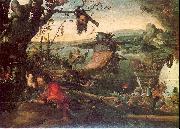 |
Mandyn, Jan -- Click Here
|
|
Dutch Northern Renaissance Painter, ca.1500-1560 |
|
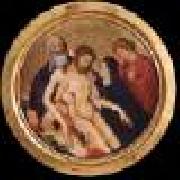 |
MALOUEL, Jean -- Click Here
|
|
Netherlandish Gothic Era Painter, ca.1365-1415
North Netherlandish painter, active in Burgundy. He was the son of the heraldic artist Willem Maelwael and uncle of the Limbourg brothers. First recorded as a painter in 1382, he is then documented on 20 September 1396 for a commission to provide designs for textiles with decorative armorial bearings for Queen Isabeau of Bavaria, wife of Charles VI, for which he received payment on 27 March 1397. By 5 August 1397 he was in Dijon, where he succeeded Jean de Beaumetz as court painter and Valet de Chambre to Philip the Bold, Duke of Burgundy. Malouel was highly paid, and his annual pension was considerably more than that of Beaumetz or of the sculptor Claus Sluter. One of the first works Malouel produced for the Duke was a painting of the Apostles with St Anthony (untraced), paid for on 11 November 1398, which the Duke is known to have kept in his private oratory. On 18 March 1398 wooden supports were purchased for Malouel to paint five large altarpieces for the Charterhouse of Champmol, outside Dijon. The subject-matter of the paintings is not specified in the document, although the dimensions of the panels are given. The Martyrdom of St Denis (Paris, Louvre; for illustration see BELLECHOSE, HENRI) has been identified as one of these five panels, on the basis of its possible provenance and its dimensions, which correspond approximately to those given in the document. In May 1416, however, Henri Bellechose received pigments to 'perfect' a painting of the Life of St Denis, and this document, in conjunction with the earlier one, has been interpreted to suggest that Bellechose completed a work left unfinished by Malouel. |
|
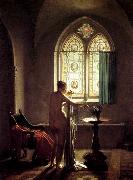 |
MALLET, Jean-Baptiste -- Click Here
|
|
French Painter, 1759-1835,French painter. A pupil of Simon Julien in Toulon, he was then taught by Pierre-Paul Prud'hon in Paris. He exhibited at every Salon between 1793 and 1827, obtaining a second class medal in 1812 and a first class medal in 1817. He executed very few portraits (Chenier, Carcassonne, Mus. B.-A., is an exception), preferring to paint nymphs bathing and graceful classical nudes such as the Graces Playing with Cupid (Arras, Abbaye St Vaast, Mus. B.-A.). He established his reputation with gouache genre scenes of fashionable and often libertine subjects, always elegant and refined, in the style of Louis-Philibert Debucourt and Louis-Leopold Boilly, and remarkable for the delicacy and brilliance of their brushwork: for example At the Laundry Maid's and the Painful Letter (both Paris, Mus. Cognacq-Jay). They reveal a knowledge of 17th-century Dutch painting in the treatment of details (transparent crystal, reflections on silk or satin) as well as the choice of themes: Military Gallant (Paris, Mus. Cognacq-Jay). Mallet's meticulously precise paintings are one of the best records of fashionable French furnishings and interiors at the end of the 18th century and the beginning of the 19th. |
|
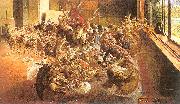 |
Malczewski, Jacek -- Click Here
|
|
Polish Painter, 1858-1929 |
|
 |
Maino, Juan Bautista del -- Click Here
|
|
Spanish Baroque Era Painter, 1578-1649 |
|
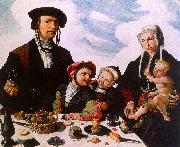 |
Maerten Jacobsz van Heemskerck -- Click Here
|
|
1498-1574
Flemish Maerten Jacobsz van Heemskerck Gallery |
|
|
|
|
|
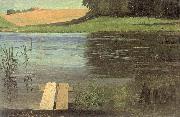 |
Lundbye, Johan Thomas -- Click Here
|
|
Danish Painter, 1818-1848
Danish painter. He studied at the Kongelige Akademi for de Sk?nne Kunster, Copenhagen, under Johan Ludvig Lund (1777-1867) and the animal painter Christian Holm (1804-46) between 1832 and 1842. Early on he was influenced by the ideas of the art historian N. L. H?yen, especially his concept of a truly national school of landscape painting. Kalundborg Church (1837; Copenhagen, Stat. Mus. Kst) depicts a historical monument familiar to all Danes, and one that had a particular nostalgic attraction for a painter born in Kalundborg. The picture is both sharply naturalistic and emphatically painterly. In Landscape Near Arres? (1838; Copenhagen, Thorvaldsens Mus.) Lundbye was more occupied with the representation of light and space. There is no anecdotal element; the lake, the open sky, the low hills, the ancient cairn, the cattle and the playing children sum up a typical Danish summer landscape. His larger canvases emphasize openness; flat expanses of land terminate in low tree-fringed horizons below vast skies. They have little of Constable's temperament or the broadness of Corot but are close to the elegiac mood of Caspar David Friedrich and Johan Christian Dahl. Danish landscape painting during the mid-1830s was greatly influenced by Romanticism |
|
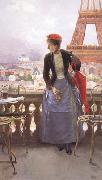 |
Luis jimenez aranda -- Click Here
|
|
Spanish Impressionist Painter, 1845-1928 |
|
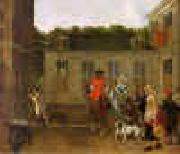 |
Ludolf de Jongh -- Click Here
|
|
1616-1679
Dutch
Ludolf de Jongh Galleries
Dutch painter. He was one of the most versatile Dutch painters of the 17th century, producing portraits, genre paintings of both domestic scenes and soldier life, landscapes with hunting scenes and a few historical subjects. According to Houbraken, he studied with Cornelis Saftleven in Rotterdam, Anthonie Palamedesz. in Delft, and Jan van Bijlert in Utrecht. In 1635 he went to France, where he stayed for seven years. His earliest known paintings are portraits and genre subjects that date from after his return to Rotterdam in about 1642 and strongly reflect the style of Palamedesz.'s work. The genre subjects and numerous hunting scenes (e.g. Riders before an Inn; Geneva, Mus. A. & Hist.) painted shortly before the 1650s show the influence of van Bijlert and other Utrecht painters, especially Jacob Duck and Dirck Stoop. |
|
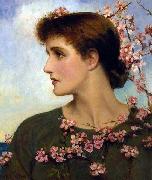 |
Louise Jopling -- Click Here
|
|
(16 November 1843 - 19 November 1933) was an English painter of the Victorian era, and one of the most prominent women artists of her generation.
Louise Goode was born in Manchester, fifth child of railway contractor T. S. Goode. She married at seventeen to civil servant Frank Romer. The Baroness de Rothschild, a connection of Romer's, encouraged Louise to pursue and develop her art. In the later 1860s she studied in Paris with Charles Joshua Chaplin and Alfred Stevens, and first exhibited her work at the Salon. She entered works into the Royal Academy shows, 1870-73 (as Louise Romer). |
|
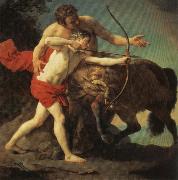 |
Louis-Jean-Francois Lagrenee -- Click Here
|
|
French Neoclassical Painter, 1725-1805 |
|
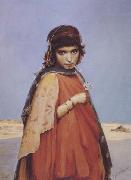 |
Louis Joseph Anthonissen -- Click Here
|
|
Belgian Painter, 1849-1913 |
|
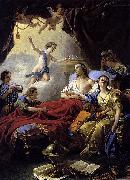 |
Louis Jean Francois Lagrenee -- Click Here
|
|
(December 30, 1724 - June 19, 1805) was a French painter, a pupil of Carlo Vanloo. His younger brother Jean-Jacques Lagren??e was also a painter.
Lagrenee was born in Paris. In 1755 he became a member of the Royal Academy, presenting as his diploma picture the Rape of Deianira (Louvre). He visited Saint Petersburg at the call of the empress Elizabeth, and on his return was named in 1781 director of the French Academy in Rome, a position he kept until 1787. He there painted the Indian Widow, one of his best-known works.
In 1804 Napoleon conferred on him the cross of the l??gion d'honneur, and on June 19, 1805 he died in the Louvre, of which he was honorary keeper.
|
|
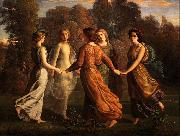 |
Louis Janmot -- Click Here
|
|
(21 May 1814 - 1 June 1892) was a French painter and poet.
Janmot was born in Lyon of Catholic parents who were deeply religious. He was extremely moved by the death of his brother in 1823 and his sister's in 1829. He became student at the Royal College of Lyon where he met Frederic Ozanam and other followers of his philosophy professor, Abbe Noirot. In 1831 he was admitted to the École des Beaux-Arts de Lyon and a year later, he won the highest honor, the Golden Laurel. In 1833, he came to Paris to take painting lessons from Victor Orsel and Jean-Auguste-Dominique Ingres. With other Lyon painters, he entered the Society of St. Vincent de Paul. In 1835, he went to Rome with Claudius Lavergne, Jean-Baptiste Frenet and other students and met Hippolyte Flandrin.
After his come back to Lyon in 1836, Janmot would attract the attention of critics of the Salon de Paris in conducting large-scale paintings with religious inspiration such as The Resurrection of the son of the widow of Nain (1839) or Christ in Gethsemane (1840). After 1845, he attracted the interest of Charles Baudelaire with his painting Flower of the Fields that allowed him to access to the Salon of 1846. Theophile Gautier was impressed by his Portrait of Lacordaire (1846). But the failure of his Poem of the Soul at the Universal Exhibition of 1855 disappointed him. In December of that year he married Leonie Saint-Paulet, from a noble family in Carpentras.
In 1856, Janmot obtained a commission to paint a fresco (since destroyed) representing the Last Supper for the church of St. Polycarp. Other orders followed, including the decoration of the dome of the Church of St. Francis de Sales and for the town hall that had been renovated by his friend the architect T. Desjardins. He was then appointed professor at the École des Beaux-Arts.
|
|
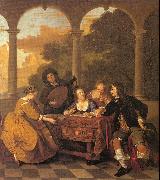 |
Loo, Jacob van -- Click Here
|
|
Flemish Baroque Era Painter, 1614-1670
was a Dutch painter and popularized around 1650 a close-focus concert on a loggia or terrace. So Van Loo became known for his conversation groupings with a subtle color palette, and according to Arnold Houbraken famous for his nudes. He was the founder of the Van Loo family of painters. Van Loo was born in Zeeland in the Dutch Republic. His father might have been a notary, but most time he is regarded as the son of a painter, Jan van Loo, who trained him. (As part of the city archives in Sluis have been destroyed during World War II it is impossible now to make out what is true). His early influences include Thomas de Keyser and Jacob Adriaensz Backer. In 1642, Jacob moved to Amsterdam, where his contemporaries included Rembrandt, Frans Hals, and Bartholomeus van der Helst. In 1643 he married the sister of the painter Martinus Lengele and had six children. They lived on Rozengracht, in the Jordaan and Eglon van der Neer became one of his pupils. In 1660, Van Loo fled the city after having fatally stabbed someone in his belly, during a fight in an inn. He was sentenced to death in absentia and was forever banned from the state of Holland. Van Loo settled in Paris, where he was admitted to the Acad??mie de peinture et de sculpture and where he died in 1670. Van Loo's work was done in the Baroque style, which had begun in Rome and which was becoming a Europe-wide phenomenon in this period. He was a major influence on Johannes Vermeer, when painting Diana and Her Companions. He painted portraits of Johan Huydecoper van Maarssenveen, his wife, his sister Leonara Huydecoper, married to Jan J. |
|
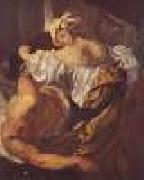 |
LISS, Johann -- Click Here
|
|
German Baroque Era Painter, ca.1597-1631 |
|
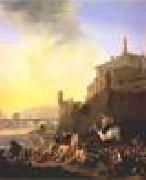 |
LINGELBACH, Johannes -- Click Here
|
|
Dutch Baroque Era Painter, 1622-1674
German painter, active in the Netherlands and Italy. By 1634 his family had settled in Amsterdam, where presumably Lingelbach trained as a painter. According to Houbraken, he visited France in 1642 and arrived in Italy two years later. However, he is not mentioned in any document of 1644, although he is recorded in Rome from 1647 to 1649. The artist left Rome in 1650 and by 1653 was back in Amsterdam, where he remained until his death. Lingelbach is perhaps the only one of the Dutch Italianates with a catalogue of numerous signed and dated works to document his artistic development. The first two signed works are The Blacksmith (1650; Rome, Melmeluzzi priv. col., see Briganti, Trezzani and Laureati, fig. 10.1) and Self-portrait with Violin (1650; Zurich, Ksthaus). Unfortunately no certain works survive from the previous years. Kren (1982) attributed a series of works depicting Roman trades, some formerly ascribed to Pieter van Laer, to Lingelbach's early career. The original group consisted of three small paintings: the Acquavita-seller, the Cake-seller and The Tobacconist (all Rome, Pal. Corsini). While these paintings have some striking points in common with the Melmeluzzi Blacksmith of 1650 and the signed Dentist on Horseback (1651; Amsterdam, Rijksmus.), it is still uncertain whether they belong to Lingelbach's pre-1650 work or are by another hand |
|
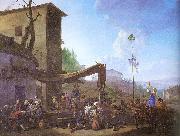 |
Lingelbach, Jan -- Click Here
|
|
Dutch Baroque Era Painter, 1622-1674 |
|
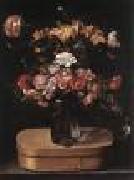 |
LINARD, Jacques -- Click Here
|
|
French Baroque Era Painter, ca.1600-1645
French painter. He was in Paris by 1626, and his first securely attributed still-life work is dated the following year. He lived in the Saint-Germain-des-Pr?s district, where a number of French still-life painters such as Louise Moillon and Lubin Baugin worked alongside Flemish artists specializing in this genre. In 1631 he was created Peintre et Valet de Chambre du Roi, a post that guaranteed him a degree of financial independence. Linard's works of 1627-44 were mainly of fruit and flowers; with Louise Moillon, however, he was among the first French artists to combine successfully the female form with still-life elements, as, for example, in Woman with Flowers and Woman with Fruit (both Paris, priv. col., see Far?, 1974, pp. 22-3). A painting such as Basket of Flowers (Paris, Louvre) owes something to Flemish prototypes in the anachronistic grouping of flowers that span several months. Patiently recording the flowers as they bloomed, and working on the picture from a series of drawings and sketches, Linard demonstrated his commitment to working from nature. However |
|
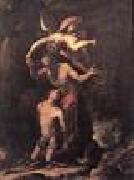 |
LIGOZZI, Jacopo -- Click Here
|
|
Italian painter, Florentine school (b. 1547, Verona, d. 1627, Firenze)
Italian painter, draughtsman, miniaturist and printmaker. He was one of the most productive artists in 17th-century Florence, although in the context of the Florentine Baroque, with its pageantry and decorative form, Ligozzi remained as much a foreigner in terms of his precise drawing, veristic figures and expressive content, as he was by birth. He was the son of the painter Giovanni Ermanno Ligozzi ( fl 1572-88; d before 1605) and came from a Veronese family of painters and designers of armour, tapestries and embroidery on silk. Other members of the family who were painters (Fumagalli in 1986 exh. cat.) were Jacopo's brother Francesco (d before 1635), whose career seems to have been in Verona, his cousin Francesco di Mercurio, who worked for the Medici in Florence in 1590-91 |
|
|